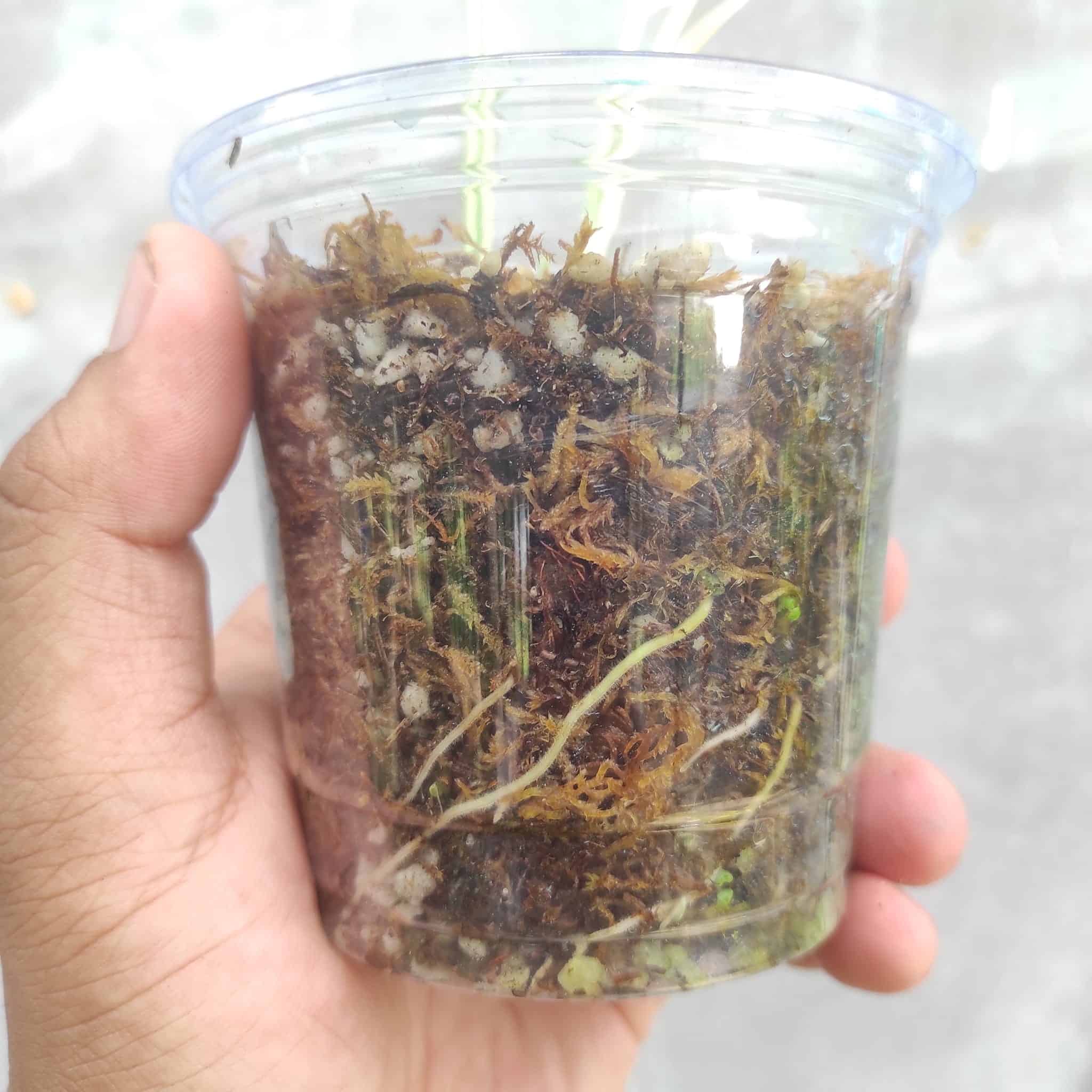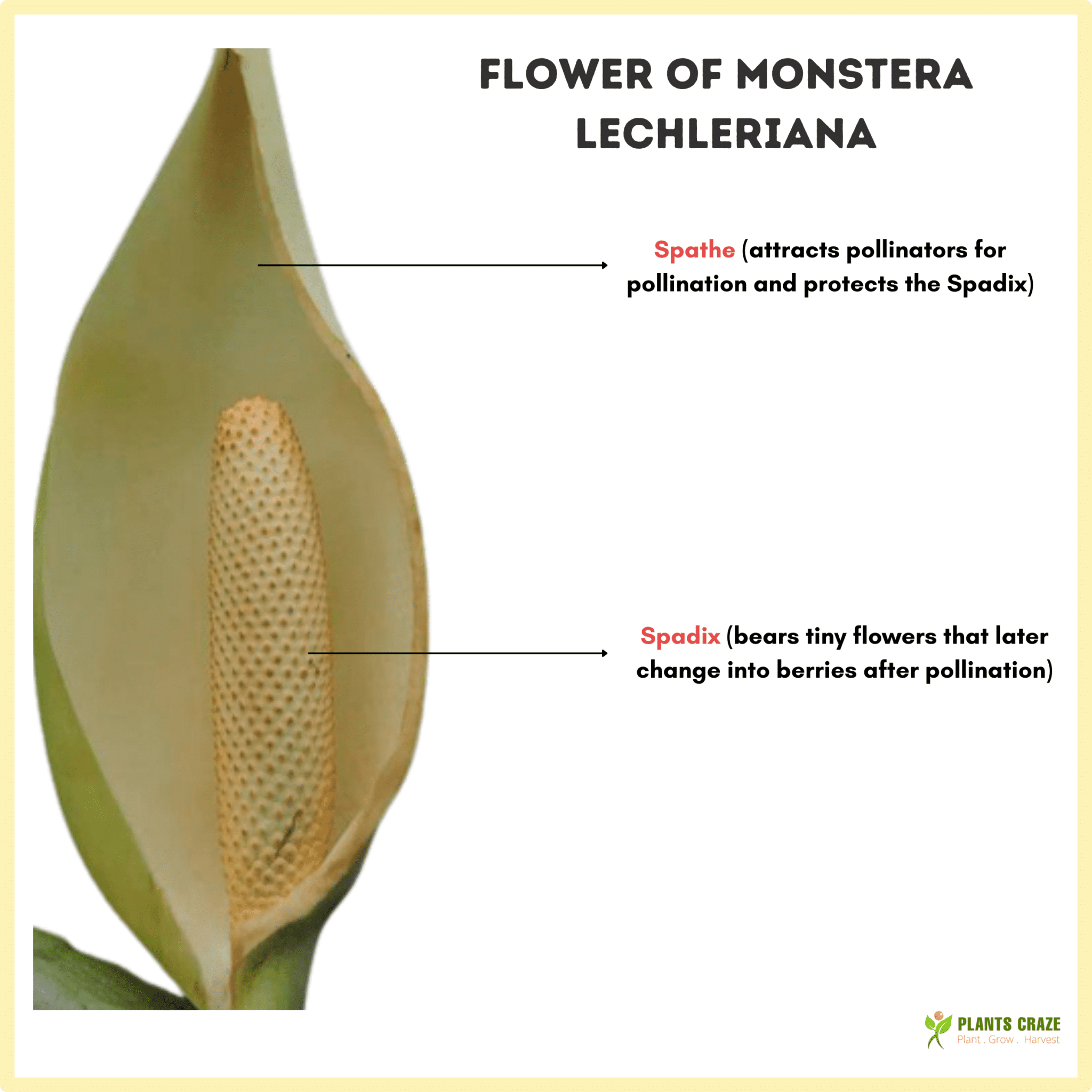Monstera Lechleriana is a shade-loving tropical plant that gloats perforated and prolific leaves requiring less care and pampers for a skywards flare.
Although Monstera Lechleriana may live long against a run down, the plant is still unsafe from pests and diseases.
So, before you fret yourself, read the article, and learn to buy, cultivate, upkeep, and save your Monstera from adversities!
Table of Contents Show
Overview of Monstera Lechleriana
Monstera Lechleriana, also known as Swiss Cheese Plant, is a magnificent tropical aroid native to the rainforests of South America.
Its name, Monstera, coming from the word “Monster,” vouches its monstrous leaves that can attain large sizes as the plant matures.

However, these humungous leaves dupe people into overlooking other cool facts about Monstera Lechleriana.
| Characteristic(s) | Description(s) |
|---|---|
| Scientific Name | Monstera lechleriana Monstera maxima Monstera henry-pittieri |
| Common Name | Monstera, Swiss-Cheese Plant, or Swiss-Cheese Philodendron |
| Family | Araceae |
| Ecology | Life Cycle: Perennial Habit: Evergreen Climbing Semi-Epiphyte Habitat: Tropical Rainforest Native Range: Bolivia, Columbia, Ecuador, Panama, Peru, and Venezuela USDA Zones: 9b to 12 |
| Height and Spread | 4-8 feet × 23 feet |
| Growth Rate | Slow to Moderate |
| Growing Seasons | Throughout Spring & Summer |
| Leaf | Shape: Ovate to Lanceolate Size: 30-47 inches long & 14-28 inches wide Texture: Glossy and Leathery Color: Dark to Pale Green |
| Flowering Period | Summer |
| Flower | Inflorescence: Spathe and Spadix Color: White to Pale Yellow Spathe and Cream to Pale Yellow Spadix Shape: Leafy Spathe and Cylindrical or Slightly Tapered Spadix |
| Grown for | Indoor Decor (Fenestrated Leaves) |
| Toxicity | Toxic to Humans and Pets (Loaded with Calcium Oxalate) |
Monstera Lechleriana for Sale
Monstera Lechleriana is a top seller in most nurseries, a much sought-after but rare tropical variety.
You can buy and welcome a new Monstera Lechleriana from these trustworthy sites at reasonable prices.
| Where to Buy | Expected Shipping Dates |
|---|---|
| Rare Home Plants | Within 3-4 days |
| Potted Elephant | Within 1 week |
| Lost In The Forrest Co. | Within 1 week |
| Leafy SoulmatesLeafy Soulmates | Within 3 days |
Ultimate Care Guide: Monstera Lechleriana
Monstera Lechleriana only needs a few hours of your watch time every week.
The plant is well-suited for indoors. But since it’s a tropical plant, you must mimic a similar forest-like environment for its growth.
Have a look at the detailed cultural care guide for Monstera Lechleriana below.

1. Sunlight & Temperature
Monstera Lechleriana naturally grows in rainforests under the shades of large trees.

The plant can face serious issues in direct sunlight due to surging temperatures during summer heat spells, especially in the leaves.
However, rapidly declining temperatures (below 55°F) combined with weak sunlight hours in winter can also affect the overall growth rate of the plant.
In such cases, Monstera Lechleriana may show some alarming signs following a change in its temperature and lighting regimes.
Signs of Excessive Sunlight and Temperatures
- Change in leaf color (green to yellow and then brown)
- Leaves getting brown and crispy at the margins and tips
- Wilting or droopy leaves and leaf stalks
Signs of Low Sunlight and Temperatures
- Floppy and droopy leaves
- Leaf and bloom drops
- Lanky growth of the overall plant
- Fading of leaf colors
Tips For Optimum Light and Temperature
- Place the plant near an east-facing window or 3-5 feet away from a south-facing window at all times.
- Use drapes to shield the plant from the blazing afternoon sun.
- Trim all the damaged parts to revitalize the plant and conserve energy for new growth.
- Always place the cut areas facing toward the light source.
- Keep the plant away from breezy north-facing windows, air conditioning vents, or heating outlets.
- Use frost blankets to cover the plants in winter.
- Place the plant 6-12 inches away from grow lights for 10-12 hours in winter if the sunlight becomes less intense.
2. Watering & Humidity
Monstera Lechleriana prefers evenly moist soil and warm, humid surroundings.
Contrarily, soggy soil can sever the connection between the shoot and root due to rots, making them unable to sustain the vigor of its leaves and stems.
The plant needs more water in spring and summer. But in fall and winter, the plant enters dormancy, so it requires less water.
Additionally, overwatering the plant is deadlier than underwatering it.
Similarly, as the plant is native to humid tropical forests, it’s more threatened by low humidity levels.
Overwatering Signs
- Root rots (foul stench from the potting soil)
- Gradual yellowing of leaves
- Limp leaves and stems

Underwatering Signs
- Fading of leaf color from yellow and then crispy brown
- Leaf curls, tip, and marginal burns
- Shriveled roots and dry potting soil
- Wilting leaves and petioles
Signs of Low Humidity
- Slow growth
- Leaf and bloom drops
- Irregular flowering and less number of blooms
Tips for Proper Watering and Humidity
- If the plant is sitting in soggy soil, move it to bright sunlight and wait for the soil water to evaporate.
- Otherwise, examine the soil by inserting your finger to assess whether the top 2 inches have dried.
- If the soil smells fishy, uproot the plant and remove the mushy roots.
- Amend the soil with extra organic perlite to increase the soil permeability.
- Keep the plant in a tray with a few inches of water and let it sit there for 15-20 minutes to saturate the soil.
- Group your Monstera with other houseplants, or put them in a humidity tray to increase the humidity levels.
3. Soil & Fertilizer
Monstera Lechleriana demands organically rich, porous, and acidic soil.
But after several watering sessions, a well-draining soil can lose all the nutrients making the plant beg for additional minerals.
However, the plant goes dormant throughout the fall and winter and doesn’t need any feed.
Offering fertilizer during such times can cause mineral salts to accumulate in the soil.

On the other hand, if the soil lacks nutrients for a long, the plant may show deficiency symptoms.
Similarly, heavy soil can smother the roots because the soil stays overly saturated with water.
Excessive Fertilizer Symptoms
- Tips and marginal crisping of leaves (fertilizer burns)
- Yellowing and browning of entire leaves
- Root burns due to high fertilizer salts
- Difficulties in mineral uptake
Signs of Mineral Deficiencies
- Leaf color changes (green to yellow, purple, or brown)
- Stunted growth
- Irregularities in the flowering cycle and bloom numbers
Tips to Offer Proper Soil and Fertilizer
- Flush out the excessive salts by keeping the plant under running distillate water 4-5 times.
- If the overfertilization symptoms persist, change the potting soil.
- Cut away all the injured roots and keep the tan-colored roots intact.
- Dilute the fertilizer to 1/4 or 1/2 strength every time to negate the effect of highly concentrated fertilizers on roots.
- Apply fertilizer right after watering the plant for an even flow of nutrients within soil layers.
4. Biennial or Triennial Repotting
Monstera Lechleriana benefits from repotting, like any other houseplant, but only if it shows the signs of root bounding.
If your Monstera shows the following root-bound signs, offer it a spacious legroom.
- Roots protruding from the drainage holes of the pot
- Noticeable cracks on the pot’s surface
- Roots shooting up from the topsoil
- Quick drainage of water without any puddling
Monstera usually loves to stay root-bound to ensure robust root growth; however, the weaker they will become, the longer they last.
In some cases, the plant infested with pests or diseases would also require repotting.
Steps to Repot Monstera Lechleriana
- Water your plant 1-2 days before repotting to tug it from the pot easily.
- Unpot the plant by taking out all the soil from the sides.
- Inspect the roots for rot, cut them, and save healthy roots.
- Fill a new pot 1/3rd with potting mix, create some cavity in the middle, and place the plant with roots facing down.
- Add more soil from the sides so the topsoil line remains an inch below the brim.
- Water the soil thoroughly to moisten the potting mix, and place the plant in bright indirect sunlight.
- If you notice your plant drooping after repotting, consider running a diagnosis for transplant shock.
5. Occasional Pruning
Monstera Lechleriana would only require pruning when it matures, as the overgrown plant takes up a lot of space.
However, frequent pruning takes a toll on the plant and stresses it out.
Pruning is also necessary to keep the plant pest and disease free.
Pests like spider mites, mealybugs, thrips, scales, and aphids hide under the leaves or around the leaf stalk and snack on the plant juice.
Similarly, leaf spots and root rots are common diseases to witness due to bacterial or fungal infections.
These outbreaks lower the overall appeal of the plant, and soon, they may crop up in other houseplants.
So, safely prune your plant by following these steps.
- Examine the damaged plant parts or the ones infected with pests or diseases.
- Cut the entire leaf right at its base using sterilized pruners.
- Prune away the dried stems or spent flowering stalks.
- Manage the leaves by trimming around the plant and offering some shape to it.
- Apply neem oil to deter pests and diseases from the plant during infestations.
- You can also stake your Monstera to guide its growth and spread.
Monstera Lechleriana: All About Growth Rate
Monstera Lechleriana can naturally climb to 23 feet by sticking to the surrounding trees in their native habitat.
When grown as a houseplant, it will easily attain a height of 4-8 feet when the conditions are correct.
Additionally, the growth of the plant paces during spring and summer.
The plant will grow vertically and have multiple leaves on the stem nodes.
Moreover, there is a variety of Monstera Lechleriana called Variegated Monstera Lechleriana or Monstera Lechleriana Albo that incorporate the variegations in their leaves.

However, its growth will slow down significantly during fall and winter as the plant becomes dormant.
Although the plant’s growth is seasonal, the leaves continue to elongate and broaden as the plant enters flowering maturity to give the plant energy for fruiting later.
Propagating Monstera Lechleriana
The successful way to multiply Monstera Lechleriana is using stem cuttings, usually done in early spring or summer.
All you need is healthy stem cuttings as propagative parts, water, and a proper potting mix as a medium for propagation.
Propagation Via Stem Cuttings
Start assessing your plant and picking out healthy stems indicated by the green, upright stem with one or more leaves.
- Choose a stem with several nodes to increase the chances of successful propagation.
- Cut the stem a few millimeters above the bottom node.
- Ensure the stem is 3-4 inches long with one or two leaves.
- Let it sit for a few days at room temperature to callous the cut end.

- Add some rooting hormone to a jar full of water and submerge the cuttings.
- Ensure the roots are plunged into the water and the leaves flare outside.
- Place it in a warm spot with bright, indirect sunlight and change the water every 3-5 days.
- The roots begin developing within 2-3 weeks. Let it sit for a few more weeks until the roots become at least 2 inches long.
- Transplant the cuttings into terracotta containers at least 4 inches wide and deep with potting soil.
You can also propagate the Monstera Lechleriana using the air layering method, which is less shocking for the plant.
Make a small cut below the node, wrap the wound with wet sphagnum moss, secure it tightly, and dampen it occasionally.
Toxicity of Monstera Lechleriana
Monstera Lechleriana can be toxic to humans and animals.
Touching the plant sap may lead to itchiness, rashes, and stinging in humans.
However, eating the plant parts may cause nausea and intense mouth, tongue, and throat irritation.
In pets, vomiting, difficulty swallowing, drooling, and diarrhea may become common when eaten in large quantities.
Consider washing your pet’s or children’s mouth with milk for home remedies to relieve the irritation.
If home remedies fail, contact America’s Poison Control Center at (800) 222-1222 immediately for poisoning in children.
Contact ASPCA Poison Control Center at (888) 426-4435 for pet poisoning.
Monstera Lechleriana vs. Laniata vs. Adansonii
Although Monstera Lechleriana and Monstera Adansonii belong to the same genus, they differ in leaves and fenestrations.
Moreover, Monstera Adansonii and Laniata are subspecies of each other.
They may be closely related but have specific structural differences due to their upbringing in different habitats.
Lechleriana leaves have larger, fewer, and more oval fenestrations toward the center.
But, Adansonii has many oval perforations spread throughout the entire leaves.
Also, Lechleria leaves are thicker and leathery, while the leaves of Adansonii are thinner and fragile.
From Editorial Team
Conclusion!
The leaves of Monstera Lechleriana have an excellent perforated appeal that appears naturally. But, unnatural fenestrations may pass off due to inappropriate cultural conditions.
Ensure to grant a conducive growing ambiance for your Monstera continually!


